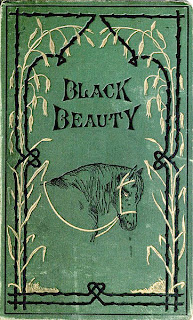 |
| Anna Sewell Anna Sewell's house in Old Catton (Norwich) |
 |
| Cover of Black Beauty first edition |
"....
there is no religion without love, and people may talk as much as they like
about their religion, but if it does not teach them to be good and kind to man
and beast, it is all a sham...."
—Black
Beauty, Chapter 13, last paragraph.
Anna Sewell was born in Norfolk,
England and had a brother named Philip, who was an engineer in Europe. At the
age of 14, Anna fell while walking home from school in the rain and injured
both ankles. Through mistreatment of the injury, she became unable to walk or
stand for any length of time for the rest of her life. Disabled and unable to
walk since she was a young child, Anna Sewell began learning about horses early
in life, spending many hours driving her father to and from the station from
which he commuted to work. Her dependence on horse-drawn transportation fostered
her respect of horses. The local estate of Tracy Park, now a golf club, was
said to be the inspiration for Black Beauty's “Birtwick Park.” Sewell's
introduction to writing began in her youth when she helped edit the works of
her mother, Mary Wright Sewell (1797–1884), a deeply religious, popular author
of juvenile best-sellers. By telling the story of a horse's life in the form of
an autobiography and describing the world through the eyes of the horse, Anna
Sewell broke new literary ground.
She never married or had
children. In visits to European spas, she met many writers, artists, and
philanthropists. Her only book was Black Beauty, written between 1871 and 1877
in their house at Old Catton. During this time, her health was declining, and
she could barely get out of bed. Her dearly-loved mother often had to help her
in her illness. She sold it to the local publishers, Jarrold & Sons. The
book broke records for sales and is the “sixth best seller in the English
language.
Sewell died of hepatitis or
tuberculosis on 25 April 1878, only 5 months after the novel was published, but
she lived long enough to see its initial success. She was buried on 30 April
1878 in the Quaker burial-ground at Lammas near Buxton, Norfolk. In Norwich,
England, not far from her resting place, is a wall plaque marking her resting
place. Her birthplace in Church Plain, Great Yarmouth is now a museum.
Sewell did not write the novel
for children. She said that her purpose in writing the novel was "to
induce kindness, sympathy, and an understanding treatment of horses - an
influence she attributed to an essay on animals she read earlier by Horace
Bushnell (1802–1876) entitled "Essay on Animals". Her sympathetic portrayal of the plight of
working animals led to a vast outpouring of concern for animal welfare and is
said to have been instrumental in abolishing the cruel practice of using the
checkrein (or "bearing rein", a strap used to keep horses' heads high,
fashionable in Victorian England but painful and damaging to a horse's neck).
Black Beauty also contains two pages about the use of blinkers on horses,
concluding that this use is likely to cause accidents at night due to
interference with "the full use of" a horse's ability to "see
much better in the dark than men can."
(sources : Anna Sewell - Wikipedia, the free encyclopedia
en.wikipedia.org/wiki/Anna_Sewell)
Black
Beauty by Anne Sewell tells about the fascinating story of the life of a horse
in the early 1800's, in England, when horses were a part of everyone's life.
Although Black Beauty's colt hood and early life were happy, he is sold from
master to master, moving from the country to London and back again.
The
story begins when Duchess, a thoroughbred mare, gives birth to Black Beauty.
The first four years of Black Beauty's life is filled with playing and
frolicking in the field. Black Beauty then sold to a wealthy man named Squire
Gordon of Birtwick Park. This is where Black Beauty meets the dream of his
life, Ginger a beautiful chestnut mare. They are then both sold, due to
injuries from their new cruel masters, and again resold to become cab horses in
London where they are cruelly treated.
Black
Beauty is a beautiful stallion that has a beautiful spirit, but is disappointed
by the cruelty of mankind. Ginger is a beautiful chestnut mare that becomes a
lifelong companion to Black Beauty, but due to mistreatment. She dies at the
hands of a horse cab driver in London. Squire Gordon is a wealthy man who is
kind to Black Beauty and Ginger, but has to sell them both when his wife
becomes ill. Joe Green works for Squire Gordon when he is young, but many years
later he finds Black Beauty by accident, and becomes his last master by
providing a comfortable life.
Jerry
Barkeris a London cab driver who also purchases Black Beauty and treats him
kindly, until Jerry becomes sick and is forced to sell Black Beauty. Things go
from bad to worse. Black Beauty endures a life of mistreatment and disrespect
in a world that shows little regard for the happiness of animals. At the end of
the story he meets kinds owners and enjoys his life.
.jpg)
.jpg)
SILK Logistics & Shipping is the best Air Freight company in Pakistan
ReplyDelete